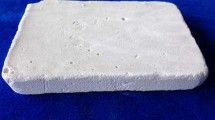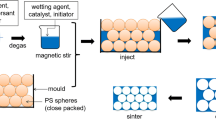Abstract
In this study, alumina foams with oriented pores were fabricated; using alumina as starting material and colloidal silica and albumin as binders via sponge replica method. Different processing parameters such as tension, chemical and thermal setting were performed for alumina foam forming. Moreover, porosity, orientation and compressive strength of the foams that fabricated in a thermal setting condition were investigated. Results showed that with the increase in compressive load during forming cause to variation of pores’ shape from spherical to ellipsoidal. In addition, the apparent densities of the samples were increased from 0.225 to 0.314 g/cm3. Moreover, compressive strength of samples was increased from 1.02 for spherical pore shaped to 2.72 and 3.71 MPa for pore aligned in major and minor axes of ellipsoid, respectively.







Similar content being viewed by others
References
P. Lemes-Rachadel, G.S. Garcia, R.A.F. Machado, D. Hotza, J.C.D. Da Costa, Current developments of mixed conducting membranes on porous substrates. Mater. Res. 44, 1439–1516 (2013)
W. Acchar, F.B.M. Souza, E.G. Ramalho, W.L. Torquato, Mechanical characterization of cellular ceramics. Mater. Sci. Eng. A 513–514, 340–343 (2009)
K. Prabhakaran, A. Melkeri, N.M. Gokhale, S.C. Sharma, Preparation of macroporous alumina ceramics using wheat particles as gelling and pore forming agent. Ceram. Int. 33, 77–81 (2007)
A.B. Sifontes, M. Urbina, F. Fajardo, L. Melo, M. Mediavilla, N. Carrion, J.L. Brito, Preparation of γ-alumina ceramic foams employing hydrophilated polyester polyurethane sponges. J. Mater. Sci. 44, 4507–4509 (2009)
A. Hadi, S. Baghshahi, R. Emadi, S. Naghavi, Different pore size alumina foams and study of their physical and mechanical properties. Mater. Sci. Eng. 132, 340–343 (2009)
S. Akpinar, I.A. Altun, K. Onel, Effects of SiC addition on the structure and properties of reticulated porous mullite ceramics. J. Eur. Ceram. Soc. 30, 2727–2734 (2010)
X. Zhu, D. Jiang, S. Tan, Improvement in the strength of reticulated porous ceramics by vacuum degassing. Mater. Lett. 51, 363–367 (2001)
T.D. Senguttuvan, H.S. Kalsi, S.K. Sharda, B.K. Das, Sintering behavior of alumina rich cordierite porous ceramics. Mater. Chem. Phys. 67, 146–150 (2001)
J. Vicente, F. Topin, J.V. Daurelle, Open celled material structural properties measurement: from morphology to transport properties. Mater. Trans. 47, 2195–2202 (2006)
J. Ordonez-Miranda, J.J. Alvarado-Gil, Effect of the pore shape on the thermal conductivity of porous media. J. Mater. Sci. 47, 6733–6740 (2012)
W.J. Lee, Y.J. Cho, H.S. Lee, I.M. Park, Y.H. Park, Effect of pore morphology on elastic, heat conduction and thermal shock fracture behaviors of porous ceramics. Procedia Eng. 10, 2459–2463 (2011)
S. Deville, E. Saiz, A.P. Tomsia, Freeze casting of hydroxyapatite scaffolds for bone tissue engineering. Biomaterials 27, 5480–5489 (2006)
J.E. Gough, D.C. Clupper, L.L. Hench, Osteoblast responses to tape cast and sintered bioactive glass ceramics. J. Biomed. Mater. Res. A 69, 621–628 (2004)
A.R. Studart, U.T. Gonzenbach, E. Tervoort, L.J. Gauckler, Processing routes to macroporous ceramics: a review. J. Am. Ceram. Soc. 89, 1771–1789 (2006)
M. Montero, T. Molina, M. Szafran, R. Moreno, M.I. Nieto, Alumina porous nanomaterials obtained by colloidal processing using d-fructose as dispersant and porosity promoter. Ceram. Int. 38, 2779–2784 (2012)
M.J. Ghaderi, M. Shafiee Afarani, G.H. Roudini, Synthesis of alumina porous supports via different compaction routes: vibration and pressing. J. Chem. Tech. Metall. 48, 289–295 (2013)
N. Heydarian Dehkordi, M. Shayesteh, M. Shafiee Afarani, A. Samimi, Effect of ammonium nitrate on microstructure and permeability characteristics of tubular alumina support using slip casting fabrication method. J. Ceram. Proc. Res. 14, 472–475 (2013)
ZhH Wen, YSh Han, L. Liang, J.B. Li, Preparation of porous ceramics with controllable pore sizes in an easy and low-cost way. Mater. Charact. 59, 1335–1338 (2008)
A. Erol, I. Yildiz, A. Yonetken, Production and characterization of alumina based ceramic filter by using simple sponge. Technology 14, 75–81 (2011)
A.B. Sifontes, M. Urbeina, F. Fajardo, L. Melo, L. Garcia, M. Mediavilla, N. Carrion, J.L. Brito, P. Hernandez, R. Solano, G. Mejias, A. Quintero, Prepartion of γ-Alumina foams of high surface area employing the polyurethane sponge replica method. Latin Am. Appl. Res. 40, 185–191 (2010)
S. Jia, L. Liu, W. Pan, G. Meng, Ch. Duan, L. Zhang, Zh Xiong, J. Liu, Oriented cartilage extracellular matrix-derived scaffold for cartilage tissue engineering. J. Biosci. Bioeng. 113, 647–653 (2012)
X. Liu, M.N. Rahaman, Q. Fu, Oriented bioactive glass (13–93) scaffolds with controllable pore size by unidirectional freezing of camphene-based suspensions: microstructure and mechanical response. Acta Biomater. 7, 406–416 (2011)
Y.W. Moon, K.H. Shin, Y.H. Koh, W.Y. Choi, H.E. Kim, Porous alumina ceramics with highly aligned pores by heat-treating extruded alumina/camphene body at temperature near its solidification point. J. Eur. Ceram. Soc. 32, 1029–1034 (2012)
L.M. Mathieu, T.L. Mueller, P.E. Bourban, D.P. Pioletti, R.E. Muller, J.A. Manson, Architecture and properties of anisotropic polymer composite scaffolds for bone tissue engineering. Biomaterials 27, 905–916 (2006)
Y. Zhang, F. Yang, K. Liu, H. Shen, Y. Zhu, W. Zhang, W. Liu, S. Wang, Y. Cao, G. Zhou, The impact of PLGA scaffold orientation on in vitro cartilage regeneration. Biomaterials 33, 2926–2935 (2012)
Q. Fu, N. Rahaman, M., Bal, B.S., F. Brown, R., In vitro cellular response to hydroxyapatite scaffolds with oriented pore architectures. Mater. Sci. Eng. C 29, 2147–2153 (2009)
J. Ordonez-Miranda, J.J. Alvarado-Gil, Effect of the pore shape on the thermal conductivity of porous media. J. Mater. Sci. 47, 6733–6740 (2012)
Author information
Authors and Affiliations
Corresponding author
Rights and permissions
About this article
Cite this article
Zahed, M., Shafiee Afarani, M. & Mohebbi-Kalhori, D. A novel method for fabrication of alumina foams with ellipsoidal aligned oriented pores. Appl. Phys. A 120, 215–220 (2015). https://doi.org/10.1007/s00339-015-9153-9
Received:
Accepted:
Published:
Issue Date:
DOI: https://doi.org/10.1007/s00339-015-9153-9




